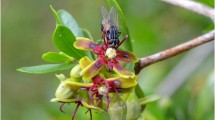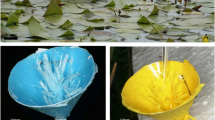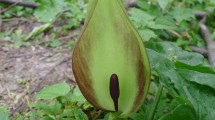Abstract
Floral scents attract pollinators to plant rewards; in nectarless flowers, pollen grains are the only reward. Thus, pollen not only fertilizes ovules, but also feeds pollinators. This dilemma is resolved by specialization of anthers (i.e., heteranthery): feeding anthers that feed pollinators and pollinating anthers for fertilization. We hypothesized that the chemical composition of floral volatiles differs between the two types of anther and influences pollination preference for feeding anthers. We used Solanum rostratum as a study model because its heterantherous flowers produce a floral scent that suggests a close association with their pollinators. The main aim of this study was to determine the chemical composition of the two types of anther and to investigate how they influence foraging behaviour of pollinators. To characterize this composition, we used solid phase microextraction and hexane extraction followed by gas chromatography-mass spectrometry. We registered 12 volatile compounds in S. rostratum floral extracts, mainly aromatic and sesquiterpene compounds. The proportion of these compounds differed between feeding and pollinating anthers. Some of these compounds were probably emitted by osmophores located in both anther types. Also, we used electroantennography to investigate Melipona solani antennal response to floral volatiles. The M. solani antennae are receptive to the highest floral extract dose tested. Finally, we conducted two behavioural bioassays to test bee attraction for each type of floral extract: a) multiple-choice in a feeding arena using M. solani and b) Y-olfactometer bioassay using Bombus impatiens. Both bee species preferred feeding anthers in bioassays. In conclusion, heteranthery involves chemical differentiation (i.e., proportion of volatiles compounds) in anther specialization that influences bee preference for feeding anthers over pollinating anthers.





Similar content being viewed by others
References
Bispo dos Santos SA, Roselino AC, Hrncir M, Bego LR (2009) Pollination of tomatoes by stingless bee Melipona quadrifasciata and the honey bee Apis mellifera (Hymenoptera, Apidae). Genet Mol Res 8:751–757
Bohs L, Weese T, Myers N, Lefgren V, Thomas N, Wagenen AV, Stern S (2007) Zygomorphy and heteranthery in Solanum in a phylogenetic context. Acta Hortic (745):201–224
Bowers KAW (1975) The pollination ecology of Solanum rostratum (Solanaceae). Am J Bot 62:633–638
Buchmann SL (1983) Buzz pollination in angiosperms. In: Jones CE, Little RJ (eds) Handbook of experimental pollination biology. Scientific and Academic Editions, New York, pp 73–113
D’Arcy WG, D’Arcy NS, Keating RC (1990) Scented anthers in the Solanaceae. Rhodora 92:50–53
Dassen S (2012) Volatiles of male and female flowers of Cucumis sativus are differentially affected by Tetranychus urticae leaf herbivory. Dissertation, Wageningen University and Research Centre
De Luca P, Vallejo-Marín M (2013) What’s the “buzz” about? The ecology and evolutionary significance of buzz-pollination. Curr Opin Plant Biol 16:429–435
Dobson HEM (1994) Floral volatiles in insect biology. In: Bernays EA (ed) Insect–plant interactions, vol V. CRC Press, Boca Raton, pp 48–70
Dobson HEM, Bergström G (2000) The ecology and evolution of pollen odors. Plant Syst Evol 222:63–87
Dobson HEM, Groth I, Bergström G (1996) Pollen advertisement: chemical contrasts between whole-flower and pollen odors. Am J Bot 83:877–885
Dobson HEM, Danielson EM, Wesep IDV (1999) Pollen odor chemicals as modulators of bumblebee foraging on Rosa rugosa Thunb. (Rosaceae). Plant Species Biol 14:153–166
Dotterl S, Vereecken NJ (2010) The chemical ecology and evolution of bee–flower interactions: a review and perspectives. Can J Zool 88:668–697
Falcão BF, Stehmann JR (2018) Functional anatomy reveals secretory activity in papillose anthers of a buzz-pollinated Solanum species (Cyphomandra clade – Solanaceae). Plant Biol 20:654–661
Friendly M, Fox J (2016) Candisc: visualization generalized canonical discriminant and canonical correlation analysis. R package version 0.7–2. https://CRAN.R-project.org/package=candisc. Accessed 16 Jul 2017
Jarau S, Hrncir M, Ayasse M, Schulz C, Francke W, Zucchi R, Barth FG (2004) A stingless bee (Melipona seminigra) marks food sources with a pheromone from its claw retractor tendons. J Chem Ecol 30:793–804
Jesson LK, Barrett SCH (2003) The comparative biology of mirror-image flowers. Int J Plant Sci 164:S237–S249
Jesson LK, Barrett SCH (2005) Experimental tests of the function of mirror-image flowers. Biol J Linn Soc 85:167–179
Kearns CA, Inouye DW (1993) Techniques for pollination biologists. University Press of Colorado. Niwot, Colorado pp 57
Knudsen JT, Tollsten L (1991) Floral scent and intrafloral scent differentiation in Moneses and Pyrola (Pyrolaceae). Plant Syst Evol 177:81–91
Knudsen JT, Eriksson R, Gershenzon J, Ståhl B (2006) Diversity and distribution of floral scent. Bot Rev 72:1–120
Kulahci IG, Dornhaus A, Papaj DR (2008) Multimodal signals enhance decision making in foraging bumble-bees. Proc R Soc B 275:797–802
Li JK, Song YP, Xu H, Zhang Y, Zhu J, Tang L (2015) High ratio of illegitimate visitation by small bees severely weakens the potential function of heteranthery. J Plant Ecol 8:213–223
Luo Z, Zhang D, Renner SS (2008) Why two kinds of stamens in buzz-pollinated flowers? Experimental support for Darwin’s division-of-labour hypothesis. Funct Ecol 22:794–800
Luo ZL, Gu L, Zhang DX (2009) Intrafloral differentiation of stamens in heterantherous flowers. J Syst Evol 47:43–56
Malo EA, Castrejón-Gómez V, Cruz-López L, Rojas JC (2004) Antennal sensilla and electrophysiological response of male and female Spodoptera frugiperda (Lepidoptera: Noctuidae) to conspecific sex pheromone and plant odors. Ann Entomol Soc Am 97:1273–1284
Maxime H (2017). RVAideMemoire: testing and plotting procedures for biostatistics. R package version 0.9–68. https://CRAN.R-project.org/package=RVAideMemoire. Accessed 23 Jan 2018
Mesquita-Neto JN, Costa BKP, Schlindwein C (2017) Heteranthery as a solution to the demand for pollen as food and for pollination-legitimate flower visitors reject flowers without feeding anthers. Plant Biol 19:942–950
Millner HJ, Baldwin TC (2016) Floral micromophology of the genus Restrepia (Orchidaceae) and the potential consequences for pollination. Flora 225:10–19
Nee M (1993) Solanaceae II. Flora de Veracruz. Instituto de Ecología, A.C./University of California Riverside CA., Xalapa pp 52
Nishida R, Shelly TE, Whittier TS, Kaneshiro KY (2000) α-Copaene, a potential rendezvous cue for the Mediterranean fruit fly, Ceratitis capitata? J Chem Ecol 26:87–100
Nunes-Silva P, Hrncir M, Da Silva CI, Roldao YS, Imperatriz-Fonseca VL (2013) Stingless bees, Melipona fasciculata, as efficient pollinators of eggplant (Solanum melongena) in greenhouses. Apidologie 44:537–546
Ogle DH (2017) FSA: fisheries stock analysis. R package version 0.8.12
Passarelli LM (1999) Morphology, reserves and pollen viability of some Solanum sect. Cyphomandropsis species. Grana 38:284–288
Passarelli L, Bruzzone L (2004) Significance of floral colour and scent in three Solanum set. Cyphomandropsis species (Solanaceae) with different floral rewards. Aust J Bot 52:659–667
R Core Development Team (2017) A language and environment for statistical computing R version 3.4.0. Vienna, Austria: The R Foundation for Statistical Computing. Available at http://www.R-project.org/
Raguso R (2008) Wake up and smell the roses: the ecology and evolution of floral scent. Annu Rev Ecol Evol Syst 39:549–569
Raguso R, Gottesberger G (2017) An ode to osmophores: Stefan Vogel’s seminal contributions to the study of scent. Flora 232:150–152
Sazima M, Vogel S, Cocucci AA, Hausner G (1993) The perfume flowers of Cyphomandra (Solanaceae); pollination by Euglossine bees, bellows mechanism, osmophores and volatiles. Plant Syst Evol 187:51–88
Schiestl FP (2010) The evolution of floral scent and insect chemical communication. Ecol Lett 13:643–656
Slaa EJ, Sánchez Chaves LA, Malagodi-Braga KS, Hofstede FE (2006) Stingless bees in applied pollination: practice and perspectives. Apidologie 37:293–315
Solís-Montero L, Vergara CH, Vallejo-Marín M (2015) High incidence of pollen theft in natural populations of a buzz-pollinated plant. Arthropod Plant Interact 9:599–611
Tan KH, Nishida R (2012) Methyl eugenol: its occurrence, distribution, and role in nature, especially in relation to insect behavior and pollination. J Insect Sci 12:1–74
Vallejo-Marín M, Manson JS, Thomson JD, Barrett SCH (2009) Division of labour within flowers: heteranthery, a floral strategy to reconcile contrasting pollen fates. J Evol Biol 22:828–839
Vallejo-Marín M, Da Silva EM, Sargent RD, Barrett SCH (2010) Trait correlates and functional significance of heteranthery in flowering plants. New Phytol 188:418–425
Vallejo-Marín M, Solís-Montero L, Souto Vilaros D, Lee MYQ (2013) Mating system in Mexican populations of the annual herb Solanum rostratum Dunal (Solanaceae). Plant Biol 15:948–954
Velloso MSC, Brito VLG, Caetano APS, Romero R (2018) Anther specializations related to the division of labor in Microlicia cordata (Spreng.) Cham. (Melastomataceae). Acta Bot Bras. https://doi.org/10.1590/0102-33062017abb0358
Weryszko-Chmielewska E, Chwil M, Sawidis T (2007) Micromorphology and histochemical traits of staminal osmophores in Asphedelus aestivus Brot. flower. Acta Agrobot 60:13–23
Wester P, Lunau K (2017) Plant-pollinator communication. In: Becard G (ed) Advances in botanical research: how plants communicate with their biotic environment, vol 82. Elsevier, London, pp 225–257
Whalen MD (1979) Taxonomy of Solanum section Androceras. Gentes Herbarum 11:359–426
Wiemer AP, Moré M, Benitez-Vieyra S, Cocucci AA, Raguso RA, Sérsic AN (2008) A simple floral fragrance and unusual osmophore structure in Cyclopogon elatus (Orchidaceae). Plant Biol 11:506–514
Wright GA, Schiestl FP (2009) The evolution of floral scent: the influence of olfactory learning by insect pollinators on the honest signalling of floral rewards. Funct Ecol 23:841–851
Zhang LJ, Lou AR (2008) Pollen limitation in invasive populations of Solanum rostratum and its relationship to population size. J Plant Ecol 8:154–158
Zhao J, Solís-Montero L, Lou A, Vallejo-Marín M (2013) Population structure and genetic diversity of native and invasive populations of Solanum rostratum (Solanaceae). PLoS One 8:e79807
Zhou HL, Yu ZF, Ye ZW, Su MS (2018) Multiplex analyses of the changes of aromatic compounds during the development of peach fruit using GC-MS and iTRAQ proteomic techniques. Sci Hortic 236:96–105
Acknowledgments
We thank the Chemical Ecology Laboratory of ECOSUR for access to materials and equipment, M. Landa, C. Solís and L. Montero for assistance during fieldwork, S. Cruz for help in data analysis and R. Bautista for SEM images. We are very grateful to M. Vallejo-Marín and anonymous referees, whose useful comments improved a previous version of this manuscript. This study was partially funded by the Consejo Nacional de Ciencia y Tecnología (CONACYT) INFR-2014-01(224846) to acquire a GC-MS.
Author information
Authors and Affiliations
Corresponding author
Rights and permissions
About this article
Cite this article
Solís-Montero, L., Cáceres-García, S., Alavez-Rosas, D. et al. Pollinator Preferences for Floral Volatiles Emitted by Dimorphic Anthers of a Buzz-Pollinated Herb. J Chem Ecol 44, 1058–1067 (2018). https://doi.org/10.1007/s10886-018-1014-5
Received:
Revised:
Accepted:
Published:
Issue Date:
DOI: https://doi.org/10.1007/s10886-018-1014-5




